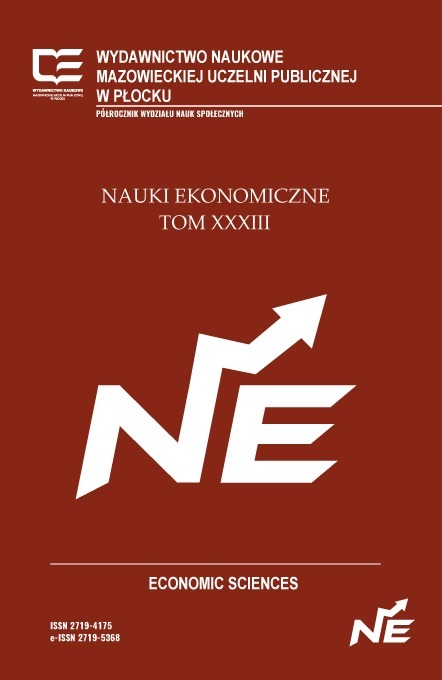THE MECHANISM OF THE CRISIS IN THE BANKING SECTO - SELECTED CAUSES AND CONSEQUENCES. THE EXPERIENCES OF THE CRISIS OF 2007-2009
DOI:
https://doi.org/10.19251/ne/2021.33(5)Keywords:
global financial and economic crisis 2007/2008, globalization of financial markets, financial institutions, stability of the banking sector, identification and man¬agement of financial risk, credit risk, bank failureAbstract
The aim of this article is to analyze the quality of risk management by financial institutions. Such an approach is important from the point of view of maintaining stability in the banking sector. Improper risk management led to the outbreak of the greatest financial and banking crisis that hit the world economy at the turn of 2007/2008. The crisis began in the US mortgage market, subsequently affected most countries in the world, especially highly developed ones in Western Europe. The collapse of the fourth largest American bank, Lehman Brothers, and the threat of bankruptcy of other American banks contributed to the spread of the crisis beyond the US borders. Information about the poor condition of banks in the US caused a crisis of confidence in the interbank market and, as a consequence, banks stopped lending money to each other, fearing the insolvency of their partners. Such a situation resulted from the American banking institutions improper identification of financial risk. Firstly, the requirements for borrowers were lowered, and secondly, inappropriate criteria for measuring credit risk were assumed, disregarding the important issue of the ability to repay loans. Therefore, proper financial risk management was and continues to be of such an importance for the stability of financial markets, not only at national level, but mainly at international one.
References
Abbassi, P., Raj I., Francesc R. T. (2016). Securities Trading by Banks and Credit Supply: Micro-Evidence. “Journal of Financial Economics”. 121(3). 569– 594.
Bouvatier, V. (2017). The frequency of banking crises in a dynamic setting: A discrete-time dura¬tion approach. “Oxford Economic Papers”. 69, no. 4, 1078-1100.
Casu, B., Girardone, C., Molyneux. P. (2015). Introduction to banking, United Kingdom: Pe¬arson.
Cecchetti, S. G., Enisse, K. (2015). Why does financial sector growth crowd out real economic growth? BIS Working Papers 490. Bank for International Settlements.
Chaudron, R., de Haan, J. (2014). Dating banking crises using incidence and size of bank failures: Four crises reconsidered. “Journal of Financial Stability”. 15, 63-75.
Czekaj, J. (2010). Wpływ światowego kryzysu gospodarczego na polską gospodarkę, w: Kołod¬ko, G. (red.). Globalizacja, kryzys i co dalej?, Warszawa. Poltext.
Dewatripont, M., Rochet, J.-Ch., Tirole, J. (2016). Zbilansowane banki. Nauki z kryzysu finan¬sowego. Warszawa. PTE.
Global Financial Stability Report. (2010). BISE.
Gostomski, E. (2016). Zmiany w sektorze bankowym w krajach Unii Europejskiej w dobie kryzy¬su. „International Business and Global Economy”. 35, 69-82.
Hernandez, L., Valdes, R. (2001). What Drives Contagion Trade, Neighborhood, or Financial Links? Working Paper WP/01/29.Washington DC: IMF. - March 2001
Homar, T. Sweder, J.G. van Wijnbergen. (2017). Bank Recapitalization and Economic Recovery after Financial Crises. “Journal of Financial Intermediation”. 32, 16–28.
Iwanicz – Drozdowska, M. (2002). Kryzysy bankowe. Przyczyny i rozwiązania, Warszawa.
Iwanicz- Drozdowska M. (2017). Zarządzanie ryzykiem bankowym, Warszawa. Poltext.
Kindleberger, Ch. P. (1999). Szaleństwo. Panika, Krach. Historia kryzysów finansowych. War¬szawa. WIG-Press.
Kozińska, M. M. (2018). Przymusowa restrukturyzacja banków w Unii Europejskiej. Warszawa. CeDeWu.
Laeven, L., Valencia, F. (2013). Systemic banking crises database. IMF Economic Review. 61, no. 2, 225-270.
Li, M., Milne, F., Qiu, J. (2020). The LOLR Policy and its Signaling Effect in a Time Crisis. “Jour¬nal of Financial Services Research”. Vol. 57, 231-252.
Li, M.., Milne, F., Qiu, J. (2013). Uncertainty in an Interconnected Financial System, Contagion, and Market Freezes. Queen’s Economics Department Working Paper, 1308.
Luc, L., Valencia, F. (2018). Systemic Banking Crises Revisited. IMF Working Paper. 206.
Nawrot, W. (2009). Globalny kryzys finansowy XXI wieku. Przyczyny, przebieg, skutki, progno¬zy, Warszawa. CeDeWu.
Pszczółka, I. (2008). Euro a integracja europejskich rynków finansowych, Warszawa: CeDeWu.
Reinhart, C. M., Rogoff, K. S. (2011). From financial crash to debt crisis. “American Economic Review”, 101, no. 5, 1676-1706.
Romer, D., Romer, Ch. (2018). Phillips Lecture – Why Some Times are Different: Macroeconomic Policy and the Aftermath of Financial Crises. “Economica”, 85, 1–40.
Rose, A. K. (2012). International Financial Integration and Crisis Intensity. Macroeconomics Working Papers 23195. East Asian Bureau of Economic Research.
Rose Andrew, Spiegel Mark. 2009. Cross country causes and consequences of the 2008 crisis: International linkage and American exposure, NBER Working Paper, 15358.
Schularick, M., Taylor, A. M. (2012). Credit Booms Gone Bust: Monetary Policy, Leverage Cycles, and Financial Crises, 1870-2008. “American Economic Review”. 102(2), 1029–1061.
Sektor bankowy w Europie. Co zmienił kryzys? (2013). Zeszyty BRE BANK – CASE, 126.
Stefański, A. (2007). Rola kwalifikacji analityków w zarządzaniu ryzykiem kredytowym w ban¬kach. Poznań. Wydawnictwo Wyższej Szkoły Bankowej.
Zaleska, M. (red.). (2013). Bankowość, Warszawa. Difin. C.H. Beck.
